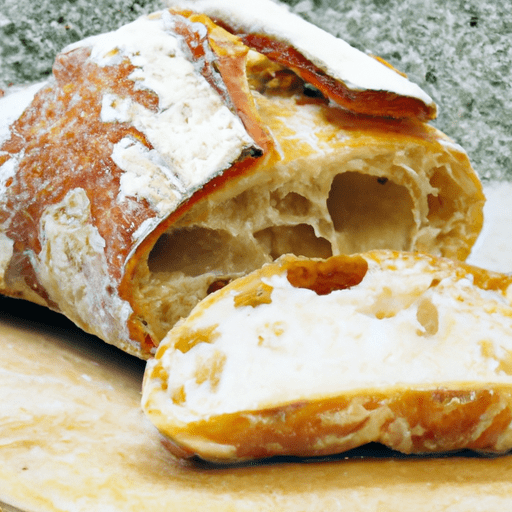Discover the Delight of Ciabatta Bread
If you’re a bread lover, you’ve probably come across ciabatta bread at some point. This delectable Italian bread, known for its rustic appearance and delightful taste, has captured the hearts and taste buds of food enthusiasts worldwide. In this article, we’ll delve into the world of ciabatta bread, exploring its unique characteristics, versatile applications in cooking, nutritional value, and uncovering interesting historical tidbits.
A Taste of Italy: Unraveling the Flavors of Ciabatta Bread
Ciabatta bread, pronounced “chuh-BAH-tuh,” originated in Italy in the 1980s and quickly gained popularity due to its exceptional taste and texture. This crusty bread boasts a distinct flavor profile, characterized by a slight tanginess and a subtle hint of sweetness. Ciabatta’s internal texture is soft and airy, with an irregularly porous structure that makes it perfect for sopping up sauces and soaking up flavors.
Versatile in the Kitchen: Embrace Ciabatta’s Culinary Possibilities
Ciabatta bread’s versatility shines through its culinary applications. This bread is an excellent choice for sandwiches and paninis, as its sturdy crust provides the ideal crunch while maintaining a soft interior. Paired with savory fillings like cured meats, cheeses, and marinated vegetables, ciabatta elevates the humble sandwich to new heights.
Additionally, ciabatta is a great accompaniment to soups and stews. The porous structure of the bread allows it to absorb the flavors of the broth, creating a fulfilling and satisfying experience. Whether used as a vessel for a hearty bowl of tomato soup or dunked into a comforting beef stew, ciabatta adds a delicious dimension to any soup-based dish.
Nutritional Highlights: Balancing Flavor and Health
When it comes to the nutritional value of ciabatta bread, it’s important to consider portion sizes and ingredients. While ciabatta itself may not typically be enriched with additional nutrients, it can be a source of carbohydrates and some essential minerals. However, due to its often large serving size, it’s worth keeping portion control in mind when enjoying this delectable bread.
From Italy to Your Breadbasket: Unveiling Ciabatta’s Origins
The creation of ciabatta bread can be credited to bakers in the Lombardy and Veneto regions of Northern Italy. Originating as a solution to replicate the airy texture of baguettes, ciabatta was crafted to meet the demands for a lighter and less dense bread option.
Interestingly, the name “ciabatta” translates to “slipper” in Italian, which refers to the shape of the bread resembling an old-fashioned slipper. The elongated, flat shape with tapered ends not only adds to its rustic charm but also contributes to its unique texture.
Ciabatta Bread: A Culinary Delight for All
In conclusion, ciabatta bread has rightfully earned its place in culinary enthusiasts’ hearts worldwide. With its harmonious blend of flavors, versatility in the kitchen, and ability to elevate countless dishes, it’s no wonder this bread has become a staple in many households. Whether you’re enjoying it as a sandwich, dipping it into a rich soup, or savoring it on its own, ciabatta delivers a delightful gastronomic experience that is sure to leave you yearning for more.
Origin: Ciabatta bread originated in Italy, specifically in the region of Lombardy. It was created by a baker named Arnaldo Cavallari in the 1980s in response to an increasing demand for a bread with a crisp crust and an airy, moist interior.
Common Uses: Ciabatta bread is commonly used for making sandwiches, due to its light texture and absorbent nature. It is especially popular for panini, where its thin crust crisps up when grilled, while maintaining a soft and chewy interior. Ciabatta can also be used for bruschetta, crostini, or enjoyed simply dipped in olive oil or soups.
Nutritional Benefits: As a bread made with simple ingredients—usually just flour, water, yeast, and salt—ciabatta does not offer significant nutritional benefits beyond being a source of carbohydrates. However, it is low in fat and cholesterol, making it a healthier choice compared to other bread varieties.
Unique Properties or Historical Significance: Ciabatta bread is distinct for its elongated, flat shape, and its porous, hole-filled crumb. This texture is achieved through a sponge-like dough that is fermented for a longer period, resulting in its characteristic lightness.
Historically, ciabatta’s creation was influenced by the French baguette, however, it had its own unique flavor and texture. Its popularity spread quickly, not just in Italy but internationally, and it has become one of the most beloved breads around the world. The name “ciabatta” actually means “slipper” in Italian, referencing its shape, which resembles a slipper or a house shoe.




Use the share button below if you liked it.
It makes me smile, when I see it.